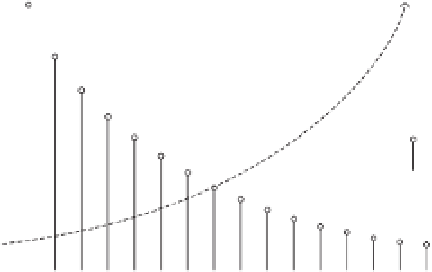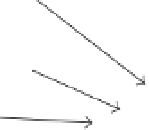Environmental Engineering Reference
In-Depth Information
Causalities always involve some amount of uncertainty.
Adding further causalities to the model will increase
the necessary details that the model will have to incor-
porate at the cost of increased uncertainty. Increased
uncertainty will lower the overall performance up to the
level where uncertainty from added causalities outweighs
added performance. This point of no improvement is
characterized as the point where more complexity costs
more in extra inputs and added inaccuracies than it
achieves in improved performance. In Figure 17.5, the
highest model performance is achieved with three causal-
ities, but further addition involves higher uncertainty, not
a better contribution to performance.
All models have this type of peak performance in
relation to number of causes, which can be several or
many hundred. By adding further components, a complex
model may end up being poorer in performance than
a simple one. It may be useful for impressing one's
colleagues with the size and complexity of the model that
you can make but for predictions it may be worse than
blind guess, and in reality completely useless.
Models are based on a series of submodels and these
submodels on further submodels in a hierarchical man-
ner. It is important to identify the system level that we
operate on. Greater numbers of components mean more
interaction between them and it becomes important to
observe the transparency between the components. A
model can have components that are on different system
levels depending on the level of details. Large models,
on a global scale, can be based on numbers that are
Effort and cost for
building model
model
component
Number of components
Figure 17.3
The number of components and their influence
are in proportion with the costs and effort of building a model.
highest performance. Then the sorting process contin-
ues downwards. If several components are identified as
outlining the main driving forces in the problem, these
components may describe the dynamics in the problem
sufficiently. Subsequently, the system boundaries can be
drawn. A problem can never be fully explained due to
uncertainties in the structure and components. Usually
the model performance will level out (Figure 17.4) and
decrease from a maximum level (Figure 17.5) even if
further causes are added. This is because adding a cause
involves adding uncertainty and at some time the accu-
mulated uncertainties will overtake the contribution to
performance (see Chapter 1).
1
4
Mechanism
number
2
5
Uncertainty loss
of performance
3
6
Mechanism
contribution to
performance
1
2 3 4
Model complexity; number of components
5
6
Figure 17.4
Adding a cause contributes to the overall performance of the model, but its contribution is not necessary symmetrical to
other causalities in the model.




































Search WWH ::

Custom Search